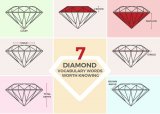
In my last blogs about the 4C’s of Diamonds, I talked about how diamonds are graded based on their “Color”, “Clarity” and “Cut”. All 3C’s play a critical role in deciding a diamond’s value. The fourth “C”, the Carat Weight refers to the actual weight of a diamond.
Most people link the Carat Weight to the size of the diamond. However, Carat is a unit of measurement of weight used to weigh a diamond. The actual size of the diamond is always measured in mm.
To understand carat weight properly, let us look at how it compares to normally units of weight.
1 Carat = 0.200 grams or 200 milligrams (yes, it’s that light).
As I mentioned in my Diamond Formationblog, it takes extremely high temperature and pressure for a diamond to be formed from carbon molecules. In fact, the chances of a diamond being formed and successfully making it to the surface of the earth are much lower than winning a lottery. Hundreds of kilometers underneath the surface of the earth, it is very unlikely that these extreme conditions remain stable and favorable for a long period of time for the growth of a large diamond. Therefore, it is very rare to find a large sized rough diamond.
No doubt, only a few monster-sized rough diamonds have been mined through history – the most famous being the 3104 carat Cullinan diamond. However, majority of the diamonds mined today are quite small in size. Here’s an interesting statistic – it requires close to one million diamonds to be mined before a one carat stone happens to be found.
Interesting Trivia: The word “Carat” comes from the ancient practice of using “Carob” seeds for measuring weight. The fact that these identical seeds were perfect in size and weight compared to one another made them ideal as a unit of measurement.
Due to this shortage of bigger diamonds, carat weight has always played a significant role in determining the price and the value of diamonds. The bigger the diamond, the rarer it is to be found. And hence the bigger the stone, the more expensive it is per carat. The price of a diamond per carat weight increases exponentially with size. For example, while a one-carat stone can fetch anywhere from $6,000 to $15,000, a sparkler of 3-4 carats could demand a price of more than $18,000 per carat depending on its color and clarity.
It is also interesting to note that as the carat weight of a diamond increases, the relative size does not increase in the same proportion. For example, the diameter of a one carat diamond is approximately 6.4 mm. However, the diameter of a two carat diamond is only 8.1 mm.
Hard Fact: Gold and diamonds, the two major components in precious jewelry, use Karat and Carat, respectively, as a unit of a measurement. Carat with a “C” applies to diamonds and it indicates the weight of the diamond. Karat, with a “K”, on the other hand, refers to the purity or fineness of gold.
![]()







